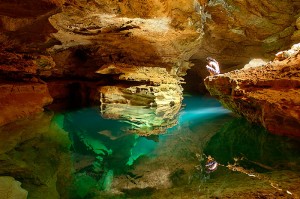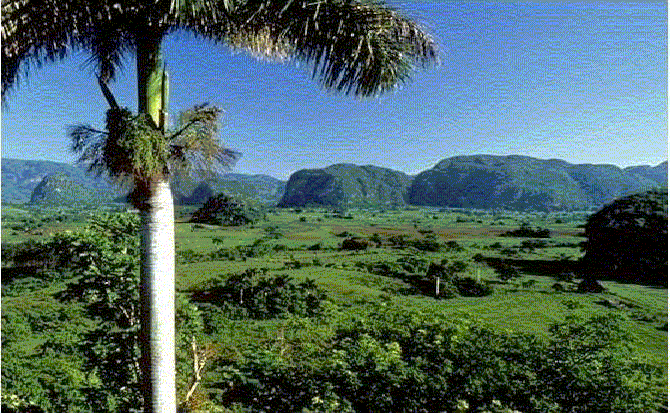THE CAVES OF BELLAMAR, CUBA: A UNIQUE SPECTACLE OF NATURE.
Bellamar caves are on the North coast of Cuba, about five kilometers from the center of the city of Matanzas. Already within the beautiful caves, visitors can see the effect of the time in their beautiful stalactites, stalagmites and other formations.
The galleries and passages of these caves began to form about 30 million years ago. Originally plain in which the caves are found under the sea, it was part of the Bay of Matanzas. Along it called failure of Bellamar the water underground, in combination with the carbon dioxide, was dissolving the rock limestone and of this form creating cameras underground in the basement; under the bottom of the sea. While these caverns remained under the level of the sea is were full of water. Then, tectonic consequences (movements in the Earth layers), this area is raised; forming the terraces marine they are noticed on the grounds in the city of Matanzas and its surroundings.
Eventually the caverns were dry; draining even cavities that are deep under the sea level. Then they began filtering through the rocks on the roof of the caves. These leaks of water with dissolved lime carbonate were leaving waste where Leaky, forming stalactites hanging from the ceiling and stalagmites in the soil. Stalactites at the beginning are cylindrical, as their size increases take taper. Stalagmites are usually conical or flattened, as melted. Grow stalactites and stalagmites, forming columns when the two come together. In some cases several stalactites are relatively fences, and according to their proportions increase you are joining, resulting in formations called matos. Other times run next to the wall, and those are the waterfalls. In the caves of Bellamar are all these formations and even more interesting is that despite the fact that already have their old, in terms of caves are relatively young; in common language meaning that even these formations are originating and those already known, to grow.
Something very interesting from the caves of Bellamar is that in them also there are formations crystal of appearance transparent and shiny. These formations do not originate in the same way as stalactites and other listed structures. These crystals have their origin in water-filled pockets. Even more interesting is that in certain cavities of the caves the sedimentary formations are covered by a Crystal layer. Which indicates that after drying, these cameras returned to flood completely, or at least partially. These caves have a beauty that is rare in the world of the caves since many of the formations are glowing due to the crystal clear film covering them.
The entrance to the caves of Bellamar is the cavity called Gothic Hall. A camera for shape is cutting and measuring about 80 meters long by 25 meters in width. In this Hall have been given name to some of the formations; others include the garden of carrots, the chapel of the twelve apostles, Doña Mamerta and perhaps the most famous is the mantle of Colon. But Bellamar caves are not only this room, the cavity extends to the East and the West achieving a length that exceeds the three kilometers long; and it is estimated to be much larger and still completely flooded Chambers. There are at least another cavity almost parallel to the North. Others of them cavities are the Gallery of them two lakes, the Salon of the sponges, the Gallery of them dwarf and it Gallery of them Megalocnus to the this of the Salon Gothic. In the other direction are the passage of Hatuey, ladies lounge, Lake of the dahlias and the bath of the American (before the English).
It was originally named La Cave de Parga, the owner of the farm where it was discovered the cave, the first to explore them and the first to show them to the world. By the way, according to scientists is a single cave with several classrooms, but as custom trafficking in plural, thus presented. Little after is you changed the name to them caves of Bellamar due to its proximity to the beach of Bellamar, to the West of the city of killings and in it costa of it Bay, where in that time is had begun to build some houses of summer.
As already mentioned, the sections that have been explored are a total length of 3,225 meters (a little more than three kilometers). There are several galleries that run parallel, and at various levels. In total they have a length of about twenty kilometers, which is considerable but not amazing in the underworld; the Mammoth Cave in Kentucky, United States, make about 580 kilometers. Of course, estimated in the caves of Bellamar there is much more to know and the Mammoth Cave is one of the most explored the world. That here is not the only crystalline formations. The Jewel Cave in the Black Hills of South Dakota, United States, has much more amazing crystal formations, but that does not take away the Bellamar, that grace of itself are a beauty.
Some sections are fifty meters below the sea level. We understand not allowing tourists go so deep; rather like up to the half of this depth. The air is breathable, at least where allowed to reach the visitor. The temperature is relatively stable throughout the year, keeping is to some 80 ° F (26 ° C).
Agencies / Wiki / InternetPhotos / Arnoldo Varona / TheCubanHistory.com
THE CUBAN HISTORY, HOLLYWOOD.
LAS CUEVAS DE BELLAMAR, CUBA: UN ESPECTÁCULO ÚNICO DE LA NATURALEZA.
Las Cuevas de Bellamar se encuentran en la costa norte de Cuba, a unos cinco kilómetros del centro de la ciudad de Matanzas. Ya dentro de las hermosas cuevas el visitante puede apreciar el efecto del tiempo en sus bellas estalactitas, estalagmitas y otras formaciones.
Las galerías y pasadizos de estas cuevas comenzaron a formarse hace unos 30 millones de años. Originalmente la planicie en la cual están las cuevas se encontraban bajo el mar, era parte de la bahía de Matanzas. A lo largo de la llamada Falla de Bellamar el agua subterránea, en combinación con el carbón dióxido, fue disolviendo la roca calcárea y de esta forma creando cámaras subterráneas en el subsuelo; bajo el fondo del mar. Mientras que estas cavernas permanecieron bajo el nivel del mar se encontraban llenas de agua. Entonces, a consecuencias tectónicas (movimientos en las capas terrestres), esta zona se elevó; formando las terrazas marinas que se notan en los terrenos en la ciudad de Matanzas y sus alrededores.
Eventualmente las cavernas se fueron secando; desaguándose aun cavidades que están a gran profundidad bajo el nivel del mar. Después comenzaron las filtraciones por entre las rocas sobre el techo de las cuevas. Estas filtraciones de agua con carbonato de cal disuelto fueron dejando residuos donde goteaban, formándose las estalactitas que cuelgan del techo y las estalagmitas en el suelo. Las estalactitas al principio son cilíndricas, según su tamaño aumenta toman la forma cónica. Las estalagmitas usualmente son cónicas o aplanadas, como derretidas. Las estalactitas crecen y las estalagmitas también, formándose columnas cuando las dos se unen. En ciertos casos varias estalactitas están relativamente cercas, y según sus proporciones aumentan se van uniendo, dando lugar a las formaciones llamadas matos. Otras veces corren próximas a la pared, y esas son las cascadas. En las Cuevas de Bellamar se ven todas estas formaciones y aun más interesante es que a pesar que ya tienen sus añitos, en términos de cuevas son relativamente jóvenes; lo cual en leguaje común quiere decir que aun estas formaciones se están originando y las ya conocidas, creciendo.
Algo muy interesante de las Cuevas de Bellamar es que en ellas también hay formaciones cristalinas de aspecto transparente y brilloso. Estas formaciones no se originan de la misma manera que las estalactitas y otras estructuras mencionadas. Estos cristales tienen su origen en geodas llenas de agua. Aun más interesante es que en ciertas cavidades de las cuevas las formaciones sedimentarias son cubiertas por una capa cristalina. Lo cual indica que después de haberse secado, estas cámaras volvieron a inundarse totalmente, o al menos parcialmente. Estas cuevas presentan una belleza poco común en el mundo de las cavernas ya que muchas de las formaciones son resplandecientes debido a la capa cristalina que las cubre.
La entrada a las Cuevas de Bellamar es por la cavidad llamada Salón Gótico. Es una cámara de forma cuadricular y mide unos 80 metros de largo por unos 25 metros de ancho. En este salón se le han dado nombre a algunas de las formaciones; entre otras se encuentra El Huerto de las Zanahorias, La Capilla de los Doce Apóstoles, Doña Mamerta y tal vez el más famoso sea el Manto de Colón. Pero las Cuevas de Bellamar no son sólo este salón, la cavidad se extiende hacia el este y el oeste logrando una longitud que sobrepasa los tres kilómetros de largo; y se estima que sea mucho más grande y con cámaras aun totalmente inundadas. También hay al menos otra cavidad casi paralela al norte. Otras de las cavidades son la Galería de los Dos Lagos, el Salón de las Esponjas, la Galería de los Enanos y la Galería de los Megalocnus al este del Salón Gótico. En la otra dirección se encuentran el pasadizo de Hatuey, Salón de las Damas, Lago de las Dalias y el Baño de la Americana (antes de la Inglesa).
Originalmente se le llamó La Cueva de Parga, el dueño de la finca donde se descubrió la cueva, el primero en explorarlas y el primero en enseñárselas al mundo. Por cierto, de acuerdo a los científicos es una sola cueva con varios salones, pero como la costumbre la trata en plural, así la presentamos. Poco después se le cambió el nombre a Las Cuevas de Bellamar debido a su proximidad a la playa de Bellamar, al oeste de la ciudad de Matanzas y en la costa de la bahía, donde en aquel tiempo se había comenzado a edificar unas casas de verano.
Como ya mencionamos, las secciones que se han explorado tienen una longitud total de 3,225 metros (poco más de tres kilómetros). Son varias galerías que corren paralelas y a varios niveles. En total tienen un largo de unos veinte kilómetros, lo cual es considerable pero no asombroso en el mundo subterráneo; la Cueva Mammoth en Kentucky, Estados Unidos, logran cerca de 580 kilómetros. Claro, se estima que en las Cuevas de Bellamar aun hay mucho más por conocer y la Cueva Mammoth es una de las más exploradas en el mundo. La que presentamos aquí tampoco es la única con formaciones cristalinas. La Jewel Cave en las Black Hills de South Dakota, Estados Unidos, tiene formaciones cristalinas mucho más asombrantes, pero eso no le quita la gracia a las de Bellamar, que de por sí son una belleza.
Algunas secciones están a cincuenta metros bajo el nivel del mar. Tenemos entendido que a los turistas no se les permite ir tan profundo; más bien como hasta la mitad de esta profundidad. El aire es respirable, al menos donde se le permitía llegar al visitante. La temperatura es relativamente estable todo el año, manteniéndose a unos 80ºF (26ºC).
Agencies/Wiki/InternetPhotos/Arnoldo Varona/TheCubanHistory.com
THE CUBAN HISTORY, HOLLYWOOD.



 * THE CAVES OF BELLAMAR, CUBA: A Unique Spectacle of Nature. (Photos). + LAS CUEVAS DE BELLAMAR, CUBA: Un Espectáculo Único de la Naturaleza.
* THE CAVES OF BELLAMAR, CUBA: A Unique Spectacle of Nature. (Photos). + LAS CUEVAS DE BELLAMAR, CUBA: Un Espectáculo Único de la Naturaleza.




